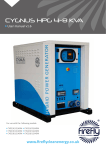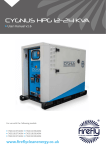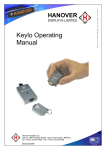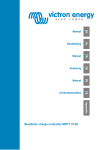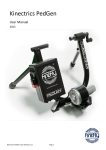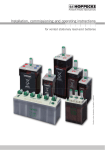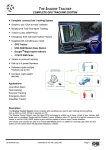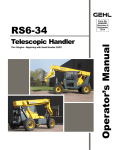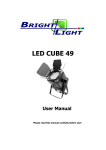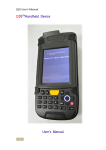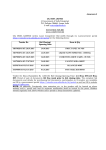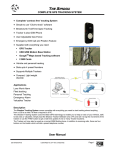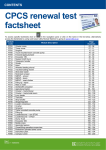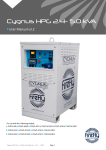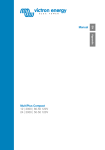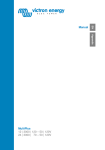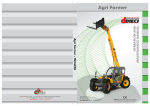Download Cygnus HPG Four User Manual
Transcript
cygnus hpg 4 User manual v1 For use with the following models: CYG4/36/90 CYG4/36/90/S CYG4/48/90 CYG4/48/90/S www.fireflycleanenergy.co.uk TABLE OF CONTENTS 1 Introduction 1.1 Foreword 1.2 Conventions 1.3 Warnings 1.4 Standards & Regulations 1.5 Disposal & Recycling 1.6 Firefly Contact Details 1.7 About Firefly 4 4 4 5 6 6 6 7 2 Getting Started 2.1 Storage 2.2 Transporting, Lifting & Positioning 2.2.1 Transportation 2.2.2 Lifting (Loading/Unloading) 2.2.3 Positioning 2.3 The Cygnus HPG Control Panel 2.4 Connecting Cygnus HPG 2.4.1 Earth attachment: Installing an Earth Rod 2.4.2 Input Options 2.4.3 Connect The AC Input 2.4.4 Connect The AC Output 8 8 8 8 8 9 10 12 12 13 13 16 3 General Operation 3.1 Turning The Power On 3.1.1 Switching On The Cygnus HPG 3.1.2 Monitoring Battery Bank State of Charge 3.1.3 Emergency Stop Button 3.1.4 Turning Off The Cygnus HPG 3.1.5 Disconnecting Cygnus HPG 3.2 Charging From An AC Supply 3.3 Care And Maintenance 3.3.1 General Cleaning 17 17 17 17 18 19 19 19 20 20 Page 2 CYGHPG4-User-Manual-v1.0 TABLE OF CONTENTS 3.3.2 Caring For The Battery Bank 3.3.3 Testing Cygnus HPG 3.4 Troubleshooting 20 20 21 4 Appendices 4.1 Connecting To A Fuel Generator For Automatic Stop/Start 4.1.1 Busbar Auxiliary Connection 4.2 Earthing Cygnus HPG 4.2.1 When Used Inline With A Fuel Powered Generator 4.2.2 When Used As A Standalone Power Source 4.2.3 When Charging A Standalone Generator from An AC Source 4.3 Keys 4.4 Warnings 4.4.1 Safety Notice Regarding The Units’ Batteries 4.5 Variable RCD 4.6 Technical Data 22 22 22 22 22 22 23 23 23 23 24 25 Figures Fig. 1 - Control Panel Fig. 2 - Earth Point Fig. 3 - Earth Rod Fig. 4 - AC Input Selector Fig. 5 - AC & Aux. Busbar Connections, Input Selector Switch Fig. 6 - Inputs, Outputs and Circuit Breakers Fig. 7 - 5 mm Double Barb Key Fig. 8 - RCC-03 Standard Display Fig. 9 - The RCC 03 Battery Monitor Screen Fig. 10 - Auxiliary Busbar Fig. 11 - Supplied Keys 10 12 12 13 14 15 17 17 18 22 23 CYGHPG4-User-Manual-v1.0 Page 3 1 Introduction 1.1 Foreword Firefly takes this opportunity to congratulate you on receiving your new Cygnus HPG. Designed and manufactured within the United Kingdom using only the finest European sourced electrical components, your new Cygnus HPG offers sustainable power generation with the reliability that you demand. The purpose of this manual is to introduce you to Cygnus HPG and provide you with a guide to its safe installation and operation. This manual describes how your Cygnus HPG works, will help you with fault finding and examines what key components are doing and why. 1.2 Conventions Throughout this user manual the following symbols are used: WARNING This symbol warns of the presence of a dangerous voltage which could cause harm to the operator or others. This symbol indicates the potential of damage to the unit or connected devices. This symbol indicates important or useful information. The following terms are used in this manual to provide greater clarity: • Firefly will be referred to as “The manufacturer”. • The Cygnus HPG Hybrid Power Generator will be referred to as “Cygnus HPG” or “Unit”. • Any items that consume power will be referred to as “Consumers”. Page 4 CYGHPG4-User-Manual-v1.0 1.3 Warnings This user manual is an important part of Cygnus HPG. It must be kept available to all operators and kept close to the unit so that it can be referred to at any time. WARNING When the unit is operating it generates potentially lethal voltages. Work must only be performed on the unit by the manufacturer or a qualified service engineer approved by the manufacturer. All items connected to the unit including distribution cables and boxes should be regularly checked and adhere to the same local regulations and standards as a regular grid-tied mains installation. CYGHPG4-User-Manual-v1.0 Page 5 1.4 Standards & Regulations Cygnus HPG conforms to the following standards and regulations: • Manufactured in compliance with ISO 9001:2008 • LVD 2006/95/EC: EN50178:1997, EN 60950:2005, EN 62040-1:2008, EN 62109-1:2010 • EMC Directive 2004/108/EC: EN 61000-6-1:2007, EN 61000-6-2:2005, EN 61000-6-3:2006, EN 61000-3-2:2006, EN 61000-3-12:2005, EN 620402:2006 • IP65 • WEEE Directive 1.5 Disposal & Recycling Cygnus HPG comprises of components that must be disposed of responsibly. For the sake of the environment many of the components within the unit can be recycled or reused. Firefly will ensure the safe decommissioning and recycling of the unit at no charge if the unit is returned to the manufacturer. Otherwise, please contact the manufacturer for more information on safe and proper decommissioning of your Cygnus HPG. 1.6 Firefly Contact Details Firefly Solar Generators Limited Unit 20 Cliffe Industrial Estate South Street Lewes East Sussex BN8 6JL United Kingdom Page 6 CYGHPG4-User-Manual-v1.0 Tel: +44 (0) 127 3 40 95 95 Fax: +44 (0) 1273 40 95 96 E-mail: [email protected] Web: www.fireflycleanenergy.co.uk IP65 1.7 About Firefly Firefly is an innovative cleantech company head quartered in the UK. Our capabilities include the design and manufacture of Hybrid Power Generators for industry, Off-Grid Power Systems for emergency response and development projects, renewable energy storage solutions that reduce grid dependence, and turnkey solutions for temporary power applications. Through our European and African hubs, and a rapidly expanding dealer network, we are making a positive social and environmental impact around the globe. The systems are manufactured in the UK, under an ISO 9001:2008 approved quality control system. Component suppliers are carefully selected to ensure high levels of reliability and performance of the final product. Installation and stringent testing is carried out to ensure compliance with EU and local legislation where applicable. CYGHPG4-User-Manual-v1.0 Page 7 2 Getting Started 2.1 Storage 1. Cygnus HPG is designed to be used and stored outside. However, to prevent unnecessary weathering it is recommended that the unit is stored inside when possible. 2. It is recommended that the battery bank is charged regularly while in storage. Refer to "3.2 Charging From An AC Supply" on page 19 for further information. 3. The emergency stop should be engaged (pushed in) and output protection switches should be switched off when in storage and not being charged to prevent unnecessary discharge of the battery bank. 2.2 Transporting, Lifting & Positioning This unit is considerably heavier than regular fuel powered generators of similar physical dimensions. Be sure to double check the capacity of lifting equipment. 2.2.1 Transportation 1. Cygnus HPG can be transported using its optional trailer, light or heavy goods vehicle with adequate available payload. Check the relevant transportation documentation for suitability. 2. The gross weight of the unit can be found on the rating plate positioned on the left hand side of the unit. 3. It is recommended that the unit is secured using suitable straps when in transit to prevent it from moving. 2.2.2 Lifting (Loading/Unloading) 1. Cygnus HPG must be loaded or unloaded using the correct equipment operated by suitably trained personnel. 2. Using the fork pockets, Cygnus HPG can be loaded or unloaded with a suitable fork-lift truck or telehandler. 3. Cygnus HPG can be safely lifted using its integral lifting ring. Page 8 CYGHPG4-User-Manual-v1.0 Refer to lifting equipment’s operation manual for lifting capacity and manufacturer’s operating instructions. Always check the rating plate to ascertain the gross weight of the unit. The unit must remain upright at all times. 2.2.3 Positioning 1. The unit must be positioned upright on a flat, solid surface. Ensure that the unit is not at risk from being submersed in water above the fork pockets. 2. The unit should be positioned as close as possible to the chosen input source (e.g. gen. set, solar array) and where necessary, close to its earth point. 3. Ensure adequate space is allowed for ventilation on all sides and that vents are not obstructed. CYGHPG4-User-Manual-v1.0 Page 9 2.3 The Cygnus HPG Control Panel 1 9 2 3 4 5 10 11 6 7 12 8 Fig. 1 - Control Panel Page 10 CYGHPG4-User-Manual-v1.0 1. 2. 3. 4. On & OffEmergency Stop- Press in to immediately halt all operation Three Phase AC Input Protection- over current MCB Single Phase AC Output Protection- RCBO earth leakage and over current breakers 5. Solar Array Isolator Switches§- Provide overload protection for the solar array inputs 6. Solar Array Inputs§- 30 A MC3 solar array connections 7. Single Phase AC Output Connectors- 32 A, 230 V AC single phase CEE Form sockets 8. Busbar Cable Entry Flaps- Provide entry for hard wired AC input/ output and auxiliary connections 9. RCC 03- Provides status and control of the unit’s inverters, battery bank, communications status and charge controller§ 10.Three Phase AC Output Protection- Variable RCD & over current MCB breakers 11.Three Phase AC Input Connector- 125 A, 400 V AC three phase CEE Form plug 12.Three Phase AC Output Connector - 125 A, 400 V AC three phase CEE Form socket § Solar inputs and charge controller only available on models with Solar Prep option CYGHPG4-User-Manual-v1.0 Page 11 2.4 Connecting Cygnus HPG WARNING When using as a standalone power source, a protective earth must be connected to the unit in compliance with applicable local standards and regulations. This can be done either by connecting to a suitable existing electrical earth, or by using an earth rod available from the manufacturer as an accessory. 2.4.1 Earth attachment: Installing an Earth Rod 1. The Earth Point of Cygnus HPG is an M10 threaded stud with washers and wing nut located on the skid to the right side of the unit. 2. Find a suitable place to drive the earth rod into the ground. The earth rod should be driven down at least half way into the ground using a mallet and placed as near to the unit as possible. 3. Check the earth cable is securely clamped to the rod. The clamp may need re-tightening after driving the earth rod down. 4. Undo the wing nut from the unit’s earth bolt and remove one of the washers. Then slide the ring terminal at the end of the earth cable onto the earth bolt. Replace the washer and securely tighten the nut. Refer to "Fig. 2 - Earth Point" Fig. 2 - Earth Point Page 12 CYGHPG4-User-Manual-v1.0 Fig. 3 - Earth Rod 2.4.2 Input Options The unit can accept inputs from a three phase AC power source. Further information on AC input connection is available in section "3.2 Charging From An AC Supply" on page 19) and solar arrays using the optional Solar Prep kit. Select The AC Input Method Before making any connections to the unit's AC input, it is necessary to select the desired input method depending on whether the unit is to be connected by hard wiring via the AC Input Busbar or using the CEE Form connector. 2.4.2.1 Selecting the desired AC input method 1. Ensure that Cygnus HPG is switched off. See "3.1.4 Turning Off The Cygnus HPG" 2. Open the lower service door by unlocking its lock located to the right hand side using the supplied key. 3. Locate the Input Selector Switch at the top left corner. See "Fig. 5 - AC & Aux. Busbar Connections, Input Selector Switch" 4. Rotate the switch to either the left to use the Busbar input, or right when using the front panel mounted CEE Form connector. See "Fig. 4 AC Input Selector" Fig. 4 - AC Input Selector 2.4.3 Connect The AC Input 2.4.3.1 Connecting with CEE Form Industrial Plugs 1. 2. 3. 4. Ensure that the AC supply being connected to the unit is switched off. Ensure the input breakers are switched off. Ensure that Cygnus HPG is switched off. Ensure that the CEE Form connectors are dry; wipe off any excess moisture with an absorbent cloth. 5. Insert the 400 V AC supply’s CEE Form industrial socket into the three phase AC Input plug. See "Fig. 6 - Inputs, Outputs and Circuit Breakers" on page 15 6. Switch on the AC input’s power supply. 7. Switch on the unit’s input breaker. CYGHPG4-User-Manual-v1.0 Page 13 2.4.3.2 Connecting by Hard Wiring Into The AC Input Busbar 1. Before any power connections are made, ensure that Cygnus HPG is switched off. 2. Open the lower service door by unlocking its lock located to the right hand side using the provided key. 3. The AC Input Busbar is located at the bottom left corner. 4. Ensure that the wire used is suitable for the application. 5. Pass the cables through the left hand rubber flap in the frame beneath the door. 6. Remove the 18 mm AF screws and nuts from the lower end of the copper bar. 7. Connect to the lower row of connections using 12 mm ring terminals. 8. Replace and tighten the screws and nuts. 1 3 2 4 5 6 1 2 3 Auxiliary Busbar AC Input Selector Switch Door Limit Switch 4 5 6 AC Input Busbar AC Outut Busbar AC Earth Busbar Fig. 5 - AC & Aux. Busbar Connections, Input Selector Switch Page 14 CYGHPG4-User-Manual-v1.0 WARNING After connecting wires to the Busbar tabs, ensure that the screws are not so long that they are touching the chassis behind. 1 2 3 6 7 4 5 1 2 3 4 5 8 Three Phase Input MCB Single Phase Output RCBOs Solar Input MCBs 30 A Solar Array Inputs 32 A Single Phase Outputs 6 7 8 9 Three Phase Input MCBs Three Phase Input Variable RCD 125 A Three Phase Input 125 A Three Phase Output Fig. 6 - Inputs, Outputs and Circuit Breakers CYGHPG4-User-Manual-v1.0 Page 15 2.4.4 Connect The AC Output 2.4.4.1 Connecting with CEE Form Industrial Plugs 1. Before any power connections are made, ensure that Cygnus HPG is switched off. See "3.1.4 Turning Off The Cygnus HPG" on page 19 2. Ensure that the output breakers are switched down into the off position. See "Fig. 6 - Inputs, Outputs and Circuit Breakers" 3. Check that the Variable RCD is set correctly. See "4.4 Variable RCD" on page 24 4. Ensure that the CEE Form connectors to be used are dry; wipe off any excess moisture with an absorbent cloth. 5. Plug the electrical consumers in to an AC Output CEE Form socket: blue for single phase or red for three phase. See "Fig. 6 - Inputs, Outputs and Circuit Breakers" on page 15 2.4.4.2 Connecting by Hard Wiring Into The AC Output Busbar 1. Before any power connections are made, ensure that Cygnus HPG is switched off. See "3.1.4 Turning Off The Cygnus HPG" 2. Open the lower service door by unlocking the locks located at its right hand side using the provided key. See 3. The AC Output Busbar is located at the bottom right corner. 4. Pass the cables through the right hand rubber flap in frame beneath the door 5. Connect to the lower row of connections using 12 mm ring terminals. 6. Remove the 18 mm nuts. 7. Attach ring terminals, referring to "Fig. 5 - AC & Aux. Busbar Connections, Input Selector Switch" on page 14 8. Replace and tighten the 18 mm nuts. Page 16 CYGHPG4-User-Manual-v1.0 3 General Operation 3.1 Turning The Power On Once all connections are complete, the AC Output of the unit is ready to be switched on. 3.1.1 Switching On The Cygnus HPG 1. Ensure that the Emergency stop button is released by rotating it clockwise. 2. Switch on the relevant breakers. For the 125 A three phase output via the CEE Form connector or the AC Output Busbar, the three phase breakers must be switched up into the on position. To use the three 63 A single phase outputs, switch on the Single Phase Output RCBOs. 3. Open the top window using the supplied double barb key. See "Fig. 7 5mm Double Barb Key" 4. Press On button. 5. The RCC-03 display should illuminate and show its standard display. See "Fig. 8 - RCC 03 Standard Display" 6. Close the top window with the key. 3.1.2 Monitoring Battery Bank State of Charge Fig. 7 - 5 mm Double Barb Key Fig. 8 - RCC-03 Standard Display The status of the unit’s internal battery bank is monitored using the RCC 03’s controls. To access the controls 1. Open the top window using the supplied key- see "Fig. 7 - 5mm Double Barb Key" 2. The RCC 03 will initially be in standby mode. Pressing any button will illuminate the display and prepare it for input 3. Press the down arrow once to access the main Battery Monitor screen 4. See "Fig. 8 - The RCC 03 Battery Monitor Screen" for a description of the available information. CYGHPG4-User-Manual-v1.0 Page 17 3 4 5 6 1 2 1 2 3 4 5 6 SoC quick overview Arrows indicate direction of current: Up = charging Down = discharging Voltage of internal battery bank Power being consumed/ Power being used to charge the battery bank SoC Percentage value During charge: Estimated time to 100% SoC During discharge: Estimated runtime at present power draw Fig. 9 - The RCC 03 Battery Monitor Screen 3.1.3 Emergency Stop Button 1. If there is an emergency and it is necessary to stop the power from the unit, depress the Emergency Stop Button (Fig. 1, C6) on the Control Panel. 2. The unit will then shut down. Cygnus HPG can not be switched on again until the Emergency Stop Button is released by twisting the red part of the button clockwise. 3. Once the problem has been rectified, follow the instructions in "3.1 Turning The Power On" on page 17 to switch the power back on. Page 18 CYGHPG4-User-Manual-v1.0 3.1.4 Turning Off The Cygnus HPG 1. Open the control centre window using the supplied key- see "Fig. 7 - 5 mm Double Barb Key" on page 17 2. Select the Off button 3. The RCC-03 screen will turn off. The unit’s internal cooling system may continue to operate when the unit is switched off 3.1.5 Disconnecting Cygnus HPG 1. Ensure that Cygnus HPG is turned off "3.1.4 Turning Off The Cygnus HPG" on page 19 2. Switch off all breakers- see "Fig. 6 - Inputs, Outputs and Circuit Breakers" on page 15 3. If an input cable is connected, disconnect it- see "Fig. 6 - Inputs, Outputs and Circuit Breakers" on page 15 4. Disconnect the output cable(s) - see "Fig. 6 - Inputs, Outputs and Circuit Breakers" on page 15 5. Remove the earth cable if one was used by unscrewing the Earth Point wing nut- see "Fig. 2 - Earth Point" on page 12 6. Replace the washer and wing nut onto the Earth Point bolt. 3.2 Charging From An AC Supply The unit can be charged via a 3 Phase 415 V AC supply from either the AC grid supply or a secondary power system. To connect an AC supply to Cygnus HPG: 1. Connect the AC Input (See "4.1 Connecting To A Fuel Generator For Automatic Stop/Start" on page 22). 2. Switch the unit on (see "3.1.1 Switching On The Cygnus HPG" on page 17 3. View the Battery Monitor display to confirm that the battery bank is charging and for detailed status (see "3.1.2 Monitoring Battery Bank State of Charge" on page 17) The unit can be used while chargingthe power automatically passes through to consumers as required. Charging time will increase when consumers are using available input current The input is factory set to accept a 63 A input. It is possible to adjust the unit to accept inputs with lower input currents. CYGHPG4-User-Manual-v1.0 Page 19 3.3 Care And Maintenance 3.3.1 General Cleaning 1. Ensure that Cygnus HPG is switched off. See "3.1.4 Turning Off The Cygnus HPG" on page 19 2. Minor cleaning should be performed using a damp microfibre cloth. 3. Detergents or chemicals should not be used. WARNING Do not use a hose or pressure washer to clean Cygnus HPG 3.3.2 Caring For The Battery Bank The Cygnus HPG battery bank uses sealed, maintenance free batteries. The only routine care necessary is to ensure that when not in use, the unit is charged at least once a month to keep the battery bank topped up. Refer to "3.2 Charging From An AC Supply" on page 19 for further information. Leaving Cygnus HPG in a state of discharge for extended periods will seriously affect its performance. 3.3.3 Testing Cygnus HPG It is recommend that the unit should be tested annually for electrical safety by a qualified electrician. Local regulations may require more frequent testing. Please refer to local regulations for further details. WARNING If Cygnus HPG fails the relevant tests, do not use or open the unit. It must only be opened by a qualified service engineer. It is recommended that a full service is performed every two years in order to ascertain the condition of your system. Please contact the manufacturer for further information. Page 20 CYGHPG4-User-Manual-v1.0 3.4 Troubleshooting Issue Possible Cause(s) Suggestion Power is on at the Cygnus HPG but the consumers are not receiving any power The output MCBs or RCDs may not be switched on Check that the MCBs and RCDs are pushed up to the on position and that the relevant output LEDs are illuminated. The emergency stop may be depressed Twist the emergency stop button clockwise to release. The door limit switch may be activated Ensure that all doors are correctly closed and all of their locks engaged. There is power being sent to Cygnus HPG but it is not charging or passing through power The input MCBs may not be switched on Check the input MCBs are pushed up to the on position and the input LEDs are on Output voltage on a phase is lower than 220 V AC over distance If the distance between the unit and the consumers is more than 50 m the voltage can drop too low. Adjust the voltage settings using the RCC 03 “Battery Voltage Too Low” Message on RCC-03 This indicates that the battery bank voltage has reached its lower limit Charge Cygnus HPG from your chosen renewable power source, from an AC grid connection or secondary power system The RCD continually trips There is an electrical fault with the consumers connected to the AC output Check the electrical integrity of the consumers being connected to the unit The MCB continually trips The consumers being connected draw too much power for the rated output of the unit Refer to the maximum output rating on the unit’s rating plate and reduce the total power draw accordingly. Generator auto start not working Auxiliary signal cable is loose or has been damaged Reattach or replace the auxiliary cable. The system power has been switched on but there is no display A Solar Array is connected to the Solar Array inputs but the Control Centre’s Solar Charge indicator does not illuminate The system has not been switched on The Solar Isolator is in the off position Ensure that the system is switched on and that isolators are in the on position. CYGHPG4-User-Manual-v1.0 Page 21 4 Appendices 4.1 Connecting To A Fuel Generator For Automatic Stop/Start Auxiliary connections are provided which allow the automatic control of a fuel powered generator. These allow Cygnus HPG to control the start up and shut down of the attached generator under pre-programmed conditions using the RCC-03. 4.1.1 Busbar Auxiliary Connection Screw terminal connections are provided behind the lower door. These are alternative connections for the same two auxiliary channels as the control panel mounted connectors. Terminal Number 1 2 3 4 5 6 Connection Aux. 1 Normally Closed Aux. 1 Common Aux. 1 Normally Open Aux. 2 Normally Closed Aux. 2 Common Aux. 2 Normally Open Fig. 10 - Auxiliary Busbar 4.2 Earthing Cygnus HPG 4.2.1 When Used Inline With A Fuel Powered Generator When Cygnus HPG is being used inline with a fuel powered generator, Cygnus HPG should not be connected to earth directly. The fuel powered generator should be earthed and the Cygnus HPG's earth connection will be made through the Busbar or CEE Form connectors. This ensures that any earth leakage is detected and managed correctly by the fuel powered generator. 4.2.2 When Used As A Standalone Power Source When used as a standalone generator, either powered solely from the internal battery bank or when receiving input from a solar array, Cygnus HPG should be connected to earth. This can be facilitated either by use of an earth rod (see "4.2 Earthing Cygnus HPG" on page 22) or connecting to a suitable existing earth point. Page 22 CYGHPG4-User-Manual-v1.0 WARNING When using Cygnus HPG with a fuel powered generator, do not connect the Cygnus HPG generator’s earth. The earth from the fuel powered generator is passed through to Cygnus HPG. For further information see "4.2 Earthing Cygnus HPG" on page 22 When replacing batteries, replace While a standalone Cygnus HPG is being charged from an AC source such as a with the same type and number of three phase grid connection or fuel powered generator which will be batteries. disconnected once the unit is charged, it is not necessary to disconnect the Cygnus HPG's earth connection. 4.2.3 When Charging A Standalone Generator from An AC Source WARNING When using as a standalone power source, a protective earth must be connected to the unit in compliance with applicable local standards and regulations. This can be done either by connecting to a suitable existing electrical earth, or by using an earth rod available from the manufacturer as an accessory. CAUTION: Do not dispose of batteries in a fire. The batteries may explode. CAUTION: Do not open or mutilate batteries. Released electrolyte is harmful to the skin and eyes. It may be toxic. 4.3 Keys Three keys are supplied with Cygnus HPG. Top window door 4.4 Warnings Lower Busbar and other blue control panel doors Large side doors Fig. 11 - Supplied Keys 4.4.1 Safety Notice Regarding The Units’ Batteries Servicing of the batteries should be performed or supervised by personnel knowledgeable about batteries and required precautions. CYGHPG4-User-Manual-v1.0 Page 23 4.5 Variable RCD A Variable RCD (Residual Current Device) Circuit Breaker is provided as part of the AC output protection system. It allows for the adjustment of the sensitivity and time delay before the Variable RCD trips. WARNING The Variable RCD is a vital safety device providing protection from potentially fatal electrocution. It is factory adjusted for standard use and should not be adjusted without consulting the manufacturer. A Variable RCD is adjusted when one or more additional RCDs are used further down the power distribution chain. Contact the manufacturer for further information before attempting to make adjustments to the Variable RCD. The Variable RCD is factory set for 30 mA sensitivity with zero delay. E & OE, ©2015 Firefly Solar Generators Ltd. Page 24 CYGHPG4-User-Manual-v1.0 4.6 Technical Data Model CYG4/36/90 CYG4/48/90 Connuous Output @ 25°c (kVA) 30 42 Peak Power Output @25°C - 30 mins (kVA) 36 48 Peak Power Output @25°C - 5 secs (kVA) 90 126 AC Output Voltage (50 Hz) 230 1Ph /400 3Ph (Both Adjustable, 110 V Oponal) AC Input Current Max (A) 100 3Ph AC Output Current Max (A) 112 160 Transfer Relay Time (ms) <15 Standby Power Consumpon (W) Inverter Protecon 28 30 Overload, Overheat, Short Circuit, Low Baery, Over Voltage, Against Excess Baery Voltage Ripple & Baery Reverse Polarity Baery Storage Type OPzV (Sealed Lead Acid) Baery Capacity @ 80 % DoD** (kWh) 90 90 Earth Fault Protecon Variable RCD Power Input Connecons Power Output Connecons 125 A 3Ph CEE Form, AC In Busbar 125 A 3Ph, 32 A 1Ph L1, 32 A 1Ph L2, 32 A 1Ph L3 CEE Form, AC Out Busbar Auxiliary Connecon (Remote Generator Start) Baery Monitoring Internal Aux. Busbar LCD Display with Voltage Indicator, Power Input / Output, Time Available, % Capacity Available, Charge State History and Baery Management English, French, Spanish, German Available Menu Languages 7.5 Charge Time Using 125 A 3Ph Inlet (Hours) 5 Set Up Time (Minutes) IP65 Water/Ingress Protecon Rang -5 to 45 Operang Temperature Range (°C) 5900 Weight (kg) Dimensions W x D x H (mm) 3000 x 1200 x 1900 Packaged Dimensions W x D x H (mm) 3056 x 1256 x 2062 Fork Pocket Dimensions W x D x H (mm) 1200 x 400 x 220 Distance Between Fork Pockets (mm) 1100 Solar Preparaon Upgrade Package* MPPT Controller with up to 14 kWp array connecon Remote Communicaon and Data Collecon Package Integrated GSM modem to collect system status, live & historic data, fault & event noficaon, external device data & control, system control & programming *Oponal upgrades available pre or post purchase of main unit. **Depth of Discharge set at factory to maximise life of baery bank. Adjustable if required. CYGHPG4-User-Manual-v1.0 Page 25

























